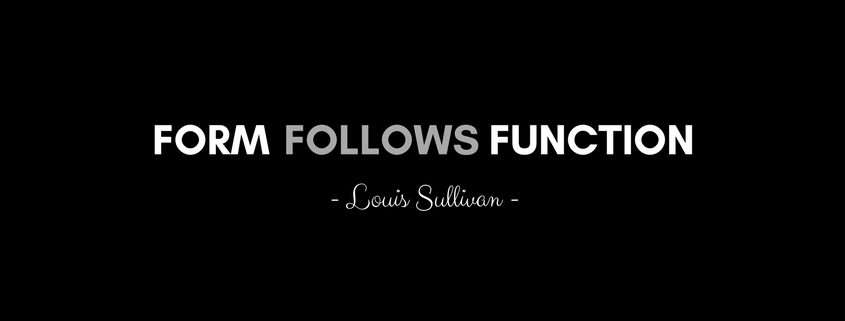Form Follows Function

Modernist architects have been credited with promoting the idea of “form follows function.” But what does it really mean and how it is applied in architecture?
Who said it?
Chicago architect and father of the skyscraper Louis Sullivan is credited with introducing the phrase to a generation of architects and industrial designers.
In his essay The Tall Office Building Artistically Considered, Sullivan suggests that in nature, “form ever follows function.” He offered examples of elements of nature, such as eagles, apple blossoms, and oak trees. Sullivan asserts that their form comes from the way the bird, flower, or tree functions.
What did he mean?
Sullivan was an independent thinker who rejected the thinking of the time in which designs were based on historic precedence.
He believed that architectural design should not be based on the past, but should originate from the intended function of the building. In other words, the purpose of a building should be the starting point for its design.
It was the spirit animating the mass and flowing from it, and it expressed the individuality of the building.
He embraced the use of modern materials and promoted the steel-framed office building – the skyscraper. Early skyscrapers resembled wedding cakes; a series of stacked layers. Sullivan believed the whole building should be a “tall soaring thing.”
The problem of the tall office building is one of the most stupendous, one of the most magnificent opportunities that the Lord of Nature in His beneficence has ever offered to the proud spirit of man.
He also considered the location of the building and designed it to reflect the local culture and industry. Although Sullivan incorporated ornamentation and decoration in his designs, others rejected this as superficial.
Who was influenced?
Sullivan’s ideas had widespread influence on contemporary architects and industrial designers.
Many of these also embraced modernism and extreme simplicity; eliminating anything that was considered extraneous or distracting. Some designers adopted the philosophy that artistic decoration was not consistent with modern forms. In some cases, the designers did not take into consideration aesthetics, human factors, and the street scale of their structures. They adopted the phrase “form follows function” to express their philosophy.
In contrast, Frank Lloyd Wright adopted Sullivan’s intent. Wright worked directly with Sullivan in Chicago and is considered to be his most famous protégé.
‘Think simple’ as my old master used to say – meaning reduce the whole of its parts into the simplest terms, getting back to first principles.
He was known for embracing organic design concepts and integrating his buildings with their natural settings. In his own architectural practice, Wright slightly extended the meaning of “form ever follows function” by changing the phrase to “form and function are one.”
Form follows function – that has been misunderstood. Form and function should be one, joined in a spiritual union.
Wright also expanded the idea beyond the building itself to include the structure’s furniture, furnishings, and interior features. The Guggenheim Museum is one such example, demonstrating his belief in the importance of the unity of the building with the artwork:
… it is not to subjugate the paintings to the building that I conceived this plan. On the contrary, it was to make the building and the painting a beautiful symphony such as never existed in the world of Art before.
How is it applied to architecture?
When we apply the phrase to architecture, we like to refer back to Louis Sullivan’s philosophy “form ever follows function.” It is a description of expressionism, in which the form should express the building’s function and that they should complement each other.
Sullivan intended that the form or shape of a structure should relate to or be based on its purpose or function. Function does not dictate the form, but the form of a structure should be an expression of the building’s function.
Read about the life of Louis Sullivan.
Read more about the Guggenheim Museum.



